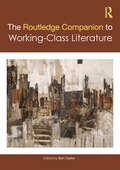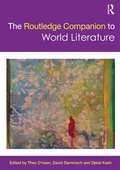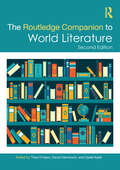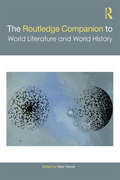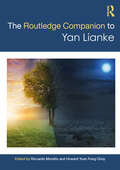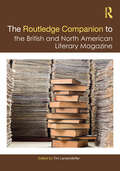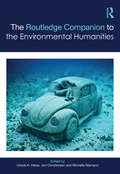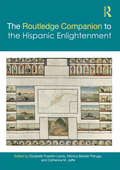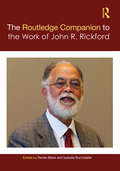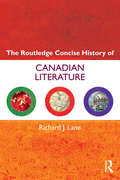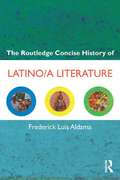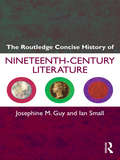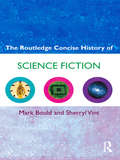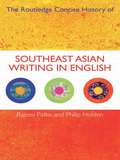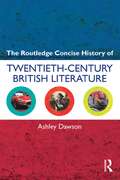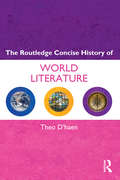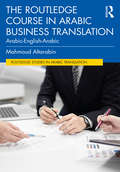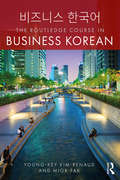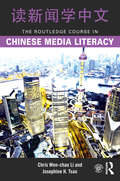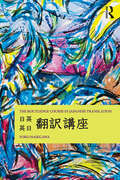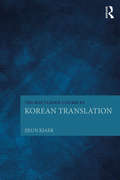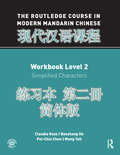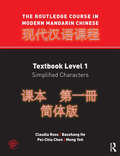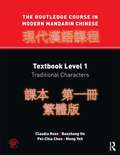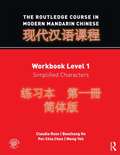- Table View
- List View
The Routledge Companion to Working-Class Literature (Routledge Literature Companions)
by Ben ClarkeThe Routledge Companion to Working-Class Literature provides an overview of the history, theory, and analysis of working-class literature. Taking a global and intersectional approach, the Companion demonstrates that literature is central to the (re)interpretation of the working class, a process that involves rereading the past as well as mapping the present.The collection examines how working-class literature is defined and the functions the term serves. It maps current debates and traces the ways in which a wide variety of theoretical and political movements have shaped the field. Challenging the stereotypical view that working-class writing is concerned solely with white, male industrial labourers in the Global North, the volume features chapters on subjects from early modern writing about the poor in England to contemporary poetry by Asian migrant workers. Exploring the theoretical problems of writing about class as well as providing detailed readings of specific texts, it demonstrates the richness and diversity of this rapidly developing field and looks to the future of working-class literature.The Routledge Companion to Working-Class Literature is an accessible, wide-ranging resource. It emphasizes difference and debate, bringing distinct texts, traditions, and critical perspectives into dialogue and is essential for any student or researcher looking at concepts of class within literary studies.
The Routledge Companion to World Literature (Routledge Literature Companions)
by David Damrosch Djelal Kadir Theo D’haenIn the age of globalization, the category of "World Literature" is increasingly important to academic teaching and research. The Routledge Companion to World Literature offers a comprehensive pathway into this burgeoning and popular field. Separated into four key sections, the volume covers: the history of World Literature through significant writers and theorists from Goethe to Said, Casanova and Moretti the disciplinary relationship of World Literature to areas such as philology, translation, globalization and diaspora studies theoretical issues in World Literature including gender, politics and ethics a global perspective on the politics of World Literature. The forty-eight outstanding contributors to this companion offer an ideal introduction to those approaching the field for the first time, or looking to further their knowledge of this extensive field.
The Routledge Companion to World Literature (Routledge Literature Companions)
by David Damrosch Djelal Kadir Theo D’haenThis fully updated new edition of The Routledge Companion to World Literature contains ten brand new chapters on topics such as premodern world literature, migration studies, world history, artificial intelligence, global Englishes, remediation, crime fiction, Lusophone literature, Middle Eastern literature, and oceanic studies. Separated into four key sections, the volume covers: • the history of world literature through significant writers and theorists from Goethe to Said, Casanova and Moretti; • the disciplinary relationship of world literature to areas such as philology, translation, globalization, and diaspora studies; • theoretical issues in world literature, including gender, politics, and ethics; and • a global perspective on the politics of world literature. Comprehensive yet accessible, this book is ideal as an introduction to world literature or for those looking to extend their knowledge of this essential field.
The Routledge Companion to World Literature and World History (Routledge Literature Companions)
by May HawasThe Routledge Companion to World Literature and World History is a comprehensive and engaging volume, combining essays from historians and literary academics to create a space for productive cross-cultural encounters between the two fields. In addition to the 27 essays, the Companion includes general introductions from two of the leading scholars of history and literature, David Damrosch and Patrick Manning, as well as personal testimonies from artists working in the area, and editorials asking provocative questions. The volume includes sections on: People – with essays looking at World Literature, Intellectual Commerce, Religion, language and war, and Indigenous ethnography Networks and methods – examining maps, geography, morality and the crises of world literature Transformations – including essays on race, colonialism, and the non-human Interdisciplinary and groundbreaking, this volume brings to light various ways in which scholars of literature and history analyse, assimilate or reveal the intellectual heritage of the past, at the same moment as they try consciously to deal with an unending amount of new information and an awareness of global connections and discrepancies. Including work from leading academics in the field, as well as newer voices, the Companion is ideal for students and scholars alike.
The Routledge Companion to Yan Lianke (Routledge Literature Companions)
by Riccardo MorattoYan Lianke is one of the most important, prolific, and controversial writers in contemporary China. At the forefront of the “mythorealist” Chinese avant-garde and using absurdist humor and grotesque satire, Yan’s works have caught much critical attention not only in the Chinese mainland, Hong Kong, and Taiwan but also around the world. His critiques of modern China under both Mao-era socialism and contemporary capitalism draw on a deep knowledge of history, folklore, and spirituality. This companion presents a collection of critical essays by leading scholars of Yan Lianke from around the world, organized into some of the key themes of his work: Mythorealism; Absurdity and Spirituality; and History and Gender, as well as the challenges of translating his work into English and other languages. With an essay written by Yan Lianke himself, this is a vital and authoritative resource for students and scholars looking to understand Yan’s works from both his own perspective and those of leading critics.
The Routledge Companion to the British and North American Literary Magazine (Routledge Literature Companions)
by Tim LanzendörferEncompassing a broad definition of the topic, this Companion provides a survey of the literary magazine from its earliest days to the contemporary moment. It offers a comprehensive theorization of the literary magazine in the wake of developments in periodical studies in the last decade, bringing together a wide variety of approaches and concerns. With its distinctive chronological and geographical scope, this volume sheds new light on the possibilities and difficulties of the concept of the literary magazine, balancing a comprehensive overview of key themes and examples with greater attention to new approaches to magazine research. Divided into three main sections, this book offers: • Theory—it investigates definitions and limits of what a literary magazine is and what it does. • History and regionalism—a very broad historical and geographic sweep draws new connections and offers expanded definitions. • Case studies—these range from key modernist little magazines and the popular middlebrow to pulp fiction, comics, and digital ventures, widening the ambit of the literary magazine. The Routledge Companion to the British and North American Literary Magazine offers new and unforeseen cross-connections across the long history of literary periodicals, highlighting the ways in which it allows us to trace such ideas as the “literary” as well as notions of what magazines do in a culture.
The Routledge Companion to the Environmental Humanities (Routledge Literature Companions)
by Jon Christensen Ursula K. Heise Michelle NiemannThe Routledge Companion to the Environmental Humanities provides a comprehensive, transnational, and interdisciplinary map to the field, offering a broad overview of its founding principles while providing insight into exciting new directions for future scholarship. Articulating the significance of humanistic perspectives for our collective social engagement with ecological crises, the volume explores the potential of the environmental humanities for organizing humanistic research, opening up new forms of interdisciplinarity, and shaping public debate and policies on environmental issues. Sections cover: The Anthropocene and the Domestication of Earth Posthumanism and Multispecies Communities Inequality and Environmental Justice? Decline and Resilience: Environmental Narratives, History, and Memory Environmental Arts, Media, and Technologies The State of the Environmental Humanities The first of its kind, this companion covers essential issues and themes, necessarily crossing disciplines within the humanities and with the social and natural sciences. Exploring how the environmental humanities contribute to policy and action concerning some of the key intellectual, social, and environmental challenges of our times, the chapters offer an ideal guide to this rapidly developing field.
The Routledge Companion to the Hispanic Enlightenment (Routledge Companions to Hispanic and Latin American Studies)
by Elizabeth Franklin Lewis Mónica Bolufer Peruga Catherine JaffeThe Routledge Companion to the Hispanic Enlightenment is an interdisciplinary volume that brings together an international team of contributors to provide a unique transnational overview of the Hispanic Enlightenment, integrating both Spain and Latin America. Challenging the usual conceptions of the Enlightenment in Spain and Latin America as mere stepsisters to Enlightenments in other countries, the Companion explores the existence of a distinctive Hispanic Enlightenment. The interdisciplinary approach makes it an invaluable resource for students of Hispanic studies and researchers unfamiliar with the Hispanic Enlightenment, introducing them to the varied aspects of this rich cultural period including the literature, visual art, and social and cultural history.
The Routledge Companion to the Work of John R. Rickford
by Isabelle Buchstaller Renée BlakeThis comprehensive collection is the first full book-length volume to bring together writing focused around and inspired by the work of John Rickford and his role in sociolinguistic research over the last four decades. Featuring contributions from more than 40 leading scholars in the field, the volume integrates both historical and current perspectives on key topics in Rickford’s body of work at the intersection of language and society, highlighting the influence of his work from diverse fields such as sociolinguistics, stylistics, creole studies, and language and education. The volume is organized around four sections, each representing one of the fundamental strands in Rickford’s scholarship over the course of his career, bookended by short vignettes that feature stories from the field to more broadly contextualize his intellectual legacy: • Language contact from a sociolinguistic and sociohistorical point of view • The political ramifications of linguistic heterogeneity • The stylistic implications of language variation and change • The educational implications of linguistic heterogeneity and social injustice Taken together, The Routledge Companion to the Work of John R. Rickford serves as a platform to showcase Rickford’s pioneering contributions to the field and, in turn, to socially reflective linguistic research more generally, making this key reading for students and researchers in sociolinguistics, creole studies, language and style, and language and education.
The Routledge Concise History of Canadian Literature (Routledge Concise Histories of Literature)
by Richard J. LaneThe Routledge Concise History of Canadian Literature introduces the fiction, poetry and drama of Canada in its historical, political and cultural contexts. In this clear and structured volume, Richard Lane outlines: the history of Canadian literature from colonial times to the present key texts for Canadian First Peoples and the literature of Quebec the impact of English translation, and the Canadian immigrant experience critical themes such as landscape, ethnicity, orality, textuality, war and nationhood contemporary debate on the canon, feminism, postcoloniality, queer theory, and cultural and ethnic diversity the work of canonical and lesser-known writers from Catherine Parr Traill and Susanna Moodie to Robert Service, Maria Campbell and Douglas Coupland. Written in an engaging and accessible style and offering a glossary, maps and further reading sections, this guidebook is a crucial resource for students working in the field of Canadian Literature.
The Routledge Concise History of Latino/a Literature (Routledge Concise Histories of Literature)
by Frederick Luis AldamaThe Routledge Concise History of Latino/a Literature presents the first comprehensive overview of these popular, experimental and diverse literary cultures. Frederick Luis Aldama traces a historical path through Latino/a literature, examining both the historical and political contexts of the works, as well as their authors and the readership. He also provides an enlightening analysis of: the differing sub-groups of Latino/a literature, including Mexican American, Cuban American, Puerto Rican American, Dominican American, and Central and South American émigré authors established and emerging literary trends such as the postmodern, historical, chica-lit storytelling formats and the graphic novel key literary themes, including gender and sexuality, feminist and queer voices, and migration and borderlands. The author’s methodology and interpretation of a wealth of information will put this rich and diverse area of literary culture into a new light for scholars. The book’s student-friendly features such as a glossary, guide to further reading, explanatory text boxes and chapter summaries, make this the ideal text for anyone approaching the area for the first time.
The Routledge Concise History of Nineteenth-Century Literature
by Ian Small Josephine GuyNineteenth-century Britain saw the rise of secularism, the development of a modern capitalist economy, multi-party democracy, and an explosive growth in technological, scientific and medical knowledge. It also witnessed the emergence of a mass literary culture which changed permanently the relationships between writers, readers and publishers.Focusing on the work of British and Irish authors, The Routledge Concise History of Nineteenth-Century Literature: considers changes in literary forms, styles and genres, as well as in critical discourses examines literary movements such as Romanticism, Pre-Raphaelitism, Aestheticism and Decadence considers the work of a wide range of canonical and non-canonical writers discusses the impact of gender studies, queer theory, postcolonialism and book history contains useful, student-friendly features such as explanatory text boxes, chapter summaries, a detailed glossary and suggestions for further reading. In their lucid and accessible manner, Josephine M. Guy and Ian Small provide readers with an understanding of the complexity and variety of nineteenth-century literary culture, as well as the historical conditions which produced it.
The Routledge Concise History of Science Fiction (Routledge Concise Histories of Literature)
by Mark Bould Sherryl VintThe term ‘science fiction’ has an established common usage, but close examination reveals that writers, fans, editors, scholars, and publishers often use this word in different ways for different reasons. Exploring how science fiction has emerged through competing versions and the struggle to define its limits, this Concise History: provides an accessible and clear overview of the development of the genre traces the separation of sf from a broader fantastic literature and the simultaneous formation of neighbouring genres, such as fantasy and horror shows the relationship between magazine and paperback traditions in sf publishing is organised by theme and presented chronologically uses text boxes throughout to highlight key works in sf traditions including dystopian, apocalyptic and evolutionary fiction includes a short overview and bullet-pointed conclusion for each chapter. Discussing the place of key works and looking forward to the future of the genre, this book is the ideal starting point both for students and all those seeking a better understanding of science fiction.
The Routledge Concise History of Southeast Asian Writing in English
by Rajeev S. Patke Philip HoldenThe Routledge Concise History of Southeast Asian Writing in English traces the development of literature in the region within its historical and cultural contexts. This volume explores creative writing in English across different genres and media, establishing connections from the colonial activity of the early modern period through to contemporary writing across Southeast Asia, focusing especially on the Philippines, Malaysia, Singapore and Hong Kong. In this critical guide, Rajeev S. Patke and Philip Holden: interweave text and context through the history of creative writing in the region examine language use and variation, making use of illuminating examples from speech, poetry and fictional prose trace the impact of historical, political and cultural events engage with current debates on national consciousness, globalization, modernity and postmodernism provide useful features including a glossary, further reading section and chapter summaries. Direct and clearly written, this Concise History guides readers through key topics while presenting a unique, original synthesis of history and practice in Southeast Asian writing in English. It is the ideal starting point for students and all those seeking a better understanding of Southeast Asian literatures and cultures.
The Routledge Concise History of Twentieth-Century British Literature (Routledge Concise Histories of Literature)
by Ashley DawsonIn The Routledge Concise History of Twentieth-Century British Literature Ashley Dawson identifies the key British writers and texts, shaped by era-defining cultural and historical events and movements from the period. He provides: Analysis of works by a diverse range of influential authors Examination of the cultural and literary impact of crucial historical, social, political and cultural events Discussion of Britain’s imperial status in the century and the diversification of the nation through Black and Asian British Literature Readers are also provided with a comprehensive timeline, a glossary of terms, further reading and explanatory text boxes featuring further information on key figures and events.
The Routledge Concise History of World Literature (Routledge Concise Histories of Literature)
by Theo D'haenThis remarkably broad and informative book offers an introduction to and overview of World Literature. Tracing the term from its earliest roots and situating it within a number of relevant contexts from postcolonialism to postmodernism, Theo D’haen examines: the return of the term "world literature" and its changing meaning Goethe’s concept of Weltliteratur and how this relates to current debates theories and theorists who have had an impact on world literature non-canonical and less-known literatures from around the globe the possibility and implications of a definition of world literature. This book is the ideal guide to an increasingly popular and important term in literary studies. It is accessible and engaging and will be invaluable to students of world literature, comparative literature, translation and postcolonial studies and anyone with an interest in these or related topics.
The Routledge Course in Arabic Business Translation: Arabic-English-Arabic (Routledge Studies in Arabic Translation)
by Mahmoud AltarabinThe Routledge Course in Arabic Business Translation: Arabic-English-Arabic is an essential coursebook for university students wishing to develop their skills in translating different types of business texts between English and Arabic. Practical in its approach, the book introduces translation students to the concept of translation and equivalence in the context of business texts, business translators, and the linguistic and syntactic features of business texts. It also highlights translation tools and technology in addition to the translation strategies which can be adopted to render business texts between English and Arabic. Key features in the book include: • Six comprehensive chapters covering (after the Introduction) the areas of economics, management, production, finance, and marketing in the translation industry; • Detailed explanation of the lexical and syntactic features of business texts; • Practical English and Arabic business translation texts featuring a vast business vocabulary bank; • Authentic business texts extracted from English and Arabic books containing economic, management, production, finance, and marketing texts; • Great range of English and Arabic translation exercises to enable students to practice their familiarity with business vocabulary they learned throughout the book; and • Glossaries following all English and Arabic business texts containing the translation of main vocabulary items. The practicality of the approach adopted in this book makes it an essential business translation coursebook for translation students. In addition, the carefully designed content helps students to easily explore different types of business texts, familiarize themselves with main words, and do translation exercises. University instructors working on English and Arabic business translations will find this book highly useful.
The Routledge Course in Business Korean
by Young-Key Kim-Renaud Miok PakThe Routledge Course in Business Korean is a textbook to teach Korean to mid-intermediate to low-advanced students learning the language used in a business context in every-day life in Korea. The authors’ intuitive approach makes it easy for students to follow the units, while the relevant and practical learning objectives benefit both student and teacher alike. The book introduces the vocabulary and key phrases of Business Korean and focuses on delivering real business-related situations, authentic expressions, and linguistically and culturally rich introductions and explanations of Korean business life. Audio files can be found on the accompanying e-Resource. By the end of this course, you will be at level B2 of the Common European Framework for Languages and Advanced Mid-High on the ACTFL proficiency scales.
The Routledge Course in Chinese Media Literacy
by Chris Wen-chao Li Josephine H. TsaoThe Routledge Course in Chinese Media Literacy is aimed at lower advanced level students of Mandarin who wish to build media literacy in the Chinese language. The book is written by university professors who have hands-on experience as media professionals. It gathers newsworthy authentic materials on topics covered by reporters on a day-to-day basis, and makes them accessible through prereading exercises, grammatical analysis, vocabulary associations, and research training for language learners. From front page headlines to business, education, crime, and sports and entertainment, the student reader will be exposed to the full scope of news coverage and become familiar with their presentation in a Chinese context. A companion website with audio, video, accompanying materials and a traditional Chinese edition is available at www.routledge.com/cw/li.
The Routledge Course in Japanese Translation
by Yoko HasegawaThe Routledge Course in Japanese Translation brings together for the first time material dedicated to the theory and practice of translation to and from Japanese. This one semester advanced course in Japanese translation is designed to raise awareness of the many considerations that must be taken into account when translating a text. As students progress through the course they will acquire various tools to deal with the common problems typically involved in the practice of translation. Particular attention is paid to the structural differences between Japanese and English and to cross-cultural dissimilarities in stylistics. Essential theory and information on the translation process are provided as well as abundant practical tasks. The Routledge Course in Japanese Translation is essential reading for all serious students of Japanese at both undergraduate and postgraduate level.
The Routledge Course in Korean Translation
by Jieun KiaerThe Routledge Course in Korean Translation brings together for the first time materials dedicated to the theory and practice of translation to and from Korean. This advanced course in Korean translation discusses cross-linguistic and cross-cultural issues that arise in the course of Korean-English and English-Korean translation and offers useful tools for dealing with the problems that arise in the actual practice of translation. Equipped with examples from a range of genres, this book provides a foundational understanding in translation theory that is necessary in Korean translation. The Routledge Course in Korean Translation is essential reading for students of Korean at both undergraduate and postgraduate levels interested in translation, as well as for students and researchers with knowledge of Korean who are interested in linguistics, and cultural and comunication studies.
The Routledge Course in Modern Mandarin Chinese Workbook Level 2 (Simplified)
by Claudia Ross Baozhang He Pei-Chia Chen Meng YehThe Routledge Course in Mandarin Chinese is a two-year undergraduate course for students with no prior background in Chinese study. Designed to build a strong foundation in both the spoken and written language it develops all the basic skills such as pronunciation, character writing, word use and structures, while placing strong emphasis on the development of communicative skills. The complete course consists of Textbook Level 1, Workbook Level 1 – including free CDs, Textbook level 2 and workbook Level 2 – including free CDs. All books are available separately in simplified as well as traditional characters and take the students from complete beginner to post-intermediate level. Workbook Level 2 is designed to accompany Textbook Level 2 lesson by lesson, and offers exercises for homework, independent study and classroom use. The exercises focus on interpersonal, interpretative and presentational modes of communication while helping students to consolidate the vocabulary, characters, and structures introduced in each lesson. At the conclusion of this course, students will be able to read page-length texts for information, listen to and comprehend extended narratives on a variety of topics, and communicate a broad range of information orally and in writing. The course is also fully supported by an interactive companion website which contains a wealth of additional resources for both teachers and students. Teachers will find lesson plans in both English and Mandarin, providing a weekly schedule and overall syllabus for fall and spring, as well as activities for each lesson and answer keys. Students will be able to access downloadable character practice worksheets along with interactive pronunciation, vocabulary and character practice exercises. All the audio material necessary for the course is also available online and conveniently linked on screen to the relevant exercises for ease-of-use. For more information about the course and to access these additional resources, please visit the Companion Website at www.routledge.com/textbooks/9780415472517 For bundle discounts please visit: For bundle discounts please visit: http://www.routledge.com/books/details/9780415533072/ ?
The Routledge Course in Modern Mandarin Chinese: Textbook Level 1, Simplified Characters
by Claudia Ross Baozhang He Pei-Chia Chen Meng YehThe Routledge Course in Modern Mandarin Chinese is a two-year undergraduate course for students with no prior background in Chinese study which takes students from complete beginner to post-intermediate level. Designed to build a strong foundation in both the spoken and written language it develops all the basic skills such as pronunciation, character writing, word use and structures, while placing strong emphasis on the development of communicative skills. Each level of the course consists of a textbook and workbook, available separately in simplified or traditional character editions. Both workbooks include a free CD with all the dialogues from the textbooks and the necessary audio for the listening for information exercises. A companion website will provide expanded listening files and a broad range of resources for students and teachers. The benefits of this course include: focus on the long-term retention of vocabulary, characters and structures by reiterating structures and vocabulary throughout the book series carefully selected and staged introduction of characters with staged removal of pinyin to ensure recognition and use of characters clear and jargon-free explanations of use and structures, that are easy for students and teachers to understand extensive workbook exercises for homework, independent study, and classroom use focusing on all language skills and modalities including a vast inventory of carefully structured exercises focusing on listening comprehension, reading for information, and writing for communication an extensive inventory of classroom activities that guide students to develop a list of communication goals and key structures for each lesson allowing the student to assess progress cultural notes explaining the context of the dialogues language FAQs explaining aspects of Chinese language as they relate to the content and vocabulary in the lesson storyline following a group of students studying in China from Europe, North America and East Asia, making the book attractive to a variety of students and facilitating the introduction of Chinese culture full-color text design for the textbook and carefully matched designs for the traditional and simplified books, allowing for easy cross-reference. The course is also fully supported by an interactive Companion Website. The website contains a wealth of additional resources for both teachers and students. Teachers will find lesson plans in both English and Mandarin, providing a weekly schedule and overall syllabus for fall and spring, as well as activities for each lesson and answer keys. Students will be able to access downloadable character practice worksheets along with interactive pronunciation, vocabulary and character practice exercises. All the audio material necessary for the course is also available online and conveniently linked on screen to the relevant exercises for ease-of-use. For further details please visit http://www.routledge.com/books/details/9780415472517/ For bundle discounts please visit http://www.routledge.com/books/details/9780415596824/
The Routledge Course in Modern Mandarin Chinese: Textbook Level 1, Traditional Characters
by Claudia Ross Baozhang He Pei-Chia Chen Meng YehThe Routledge Course in Modern Mandarin Chinese is a two-year undergraduate course for students with no prior background in Chinese study which takes students from complete beginner to post-intermediate level. Designed to build a strong foundation in both the spoken and written language it develops all the basic skills such as pronunciation, character writing, word use and structures, while placing strong emphasis on the development of communicative skills. Each level of the course consists of a textbook and workbook, available separately in simplified or traditional character editions. Both workbooks include a free CD with all the dialogues from the textbooks and the necessary audio for the listening for information exercises. A companion website will provide expanded listening files and a broad range of resources for students and teachers. The benefits of this course include: -focus on the long-term retention of vocabulary, characters and structures by reiterating structures and vocabulary throughout the book series -carefully selected and staged introduction of characters with staged removal of pinyin to ensure recognition and use of characters -clear and jargon-free explanations of use and structures, that are easy for students and teachers to understand -extensive workbook exercises for homework, independent study, and classroom use focusing on all language skills and modalities including a vast inventory of carefully structured exercises focusing on listening comprehension, reading for information, and writing for communication - an extensive inventory of classroom activities that guide students to develop communication-based speaking and listening skills. -a list of communication goals and key structures for each lesson allowing the student to assess progress -cultural notes explaining the context of the dialogues - language FAQs explaining aspects of Chinese language as they relate to the content and vocabulary in the lesson -storyline following a group of students studying in China from Europe, North America and East Asia, making the book attractive to a variety of students and facilitating the introduction of Chinese culture. -full-color text design for the textbook and carefully matched designs for the traditional and simplified books, allowing for easy cross-reference The course is also fully supported by an interactive companion website. The website contains a wealth of additional resources for both teachers and students. Teachers will find lesson plans in both English and Mandarin, providing a weekly schedule and overall syllabus for fall and spring, as well as activities for each lesson and answer keys. Students will be able to access downloadable character practice worksheets along with interactive pronunciation, vocabulary and character practice exercises. All the audio material necessary for the course is also available onliine and conveniently linked on screen to the relevant exercises for ease-of-use. For further details please visit http://www.routledge.com/books/details/9780415472517/ For bundle discounts please visit http://www.routledge.com/books/details/9780415596862/
The Routledge Course in Modern Mandarin Chinese: Workbook Level 1, Simplified Characters
by Claudia Ross Baozhang He Pei-Chia Chen Meng YehThe Routledge Course in Modern Mandarin Chinese is a two-year undergraduate course for students with no prior background in Chinese study which takes students from complete beginner to post-intermediate level. Designed to build a strong foundation in both the spoken and written language it develops all the basic skills such as pronunciation, character writing, word use and structures, while placing strong emphasis on the development of communicative skills. Each level of the course consists of a textbook and workbook, available separately in simplified or traditional character editions. Both workbooks include a free CD with all the dialogues from the textbooks and the necessary audio for the listening for information exercises. A companion website will provide expanded listening files and a broad range of resources for students and teachers. The benefits of this course include: -focus on the long-term retention of vocabulary, characters and structures by reiterating structures and vocabulary throughout the book series -carefully selected and staged introduction of characters with staged removal of pinyin to ensure recognition and use of characters -clear and jargon-free explanations of use and structures, that are easy for students and teachers to understand -extensive workbook exercises for homework, independent study, and classroom use focusing on all language skills and modalities including a vast inventory of carefully structured exercises focusing on listening comprehension, reading for information, and writing for communication - an extensive inventory of classroom activities that guide students to develop communication-based speaking and listening skills. -a list of communication goals and key structures for each lesson allowing the student to assess progress -cultural notes explaining the context of the dialogues - language FAQs explaining aspects of Chinese language as they relate to the content and vocabulary in the lesson -storyline following a group of students studying in China from Europe, North America and East Asia, making the book attractive to a variety of students and facilitating the introduction of Chinese culture. -full-color text design for the textbook and carefully matched designs for the traditional and simplified books, allowing for easy cross-reference The course is also fully supported by an interactive companion website. The website contains a wealth of additional resources for both teachers and students. Teachers will find lesson plans in both English and Mandarin, providing a weekly schedule and overall syllabus for fall and spring, as well as activities for each lesson and answer keys. Students will be able to access downloadable character practice worksheets along with interactive pronunciation, vocabulary and character practice exercises. All the audio material necessary for the course is also available online and conveniently linked on screen to the relevant exercises for ease-of-use. For further details please visit http://www.routledge.com/books/details/9780415472517/ For bundle discounts please visit http://www.routledge.com/books/details/9780415596824/
